remove LOTUS ELISE 2005 Owner's Manual
[x] Cancel search | Manufacturer: LOTUS, Model Year: 2005, Model line: ELISE, Model: LOTUS ELISE 2005Pages: 205, PDF Size: 4.51 MB
Page 102 of 205
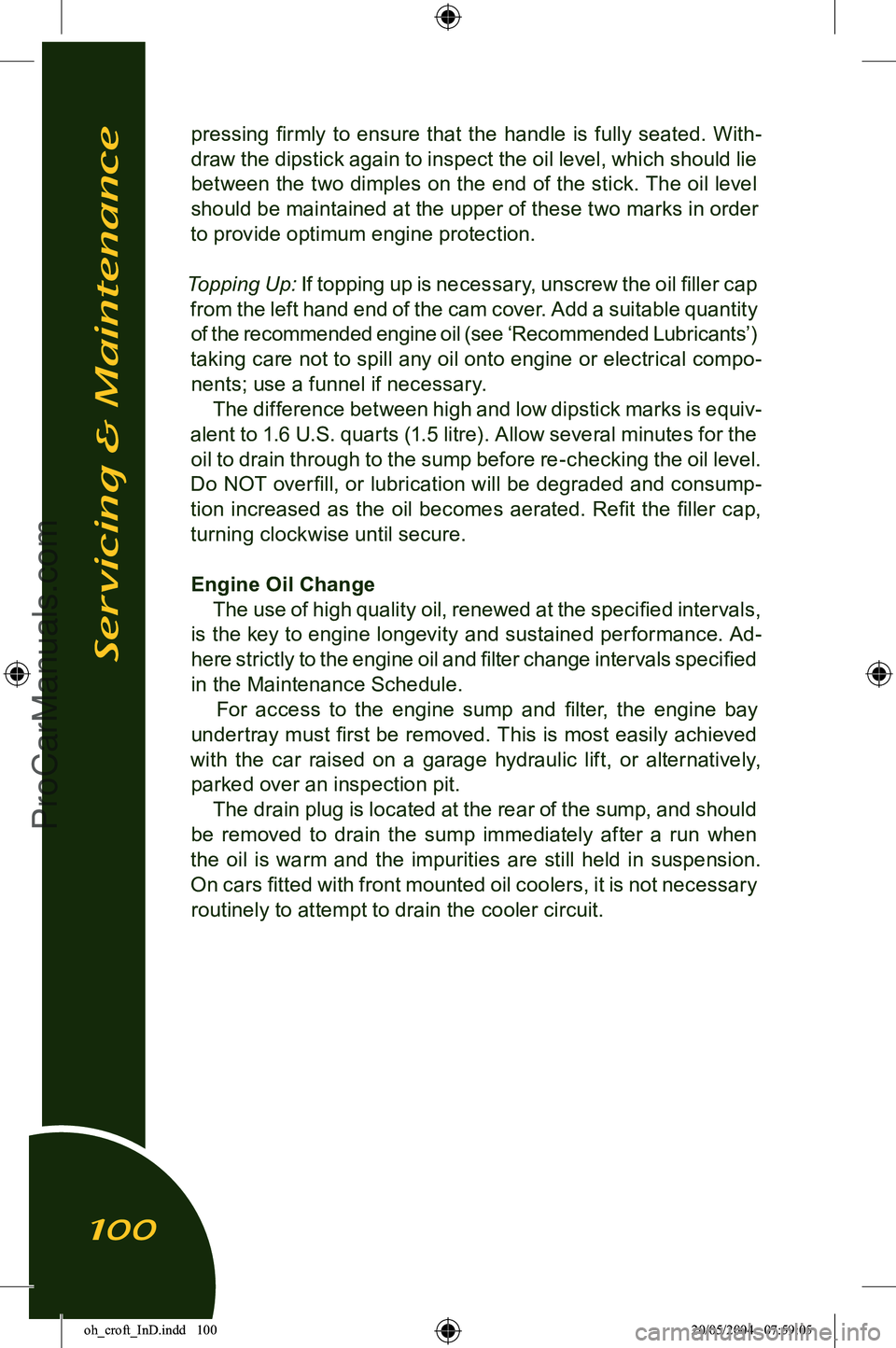
pressing firmly to ensure that the handle is fully seated. With-
draw the dipstick again to inspect the oil level, which should lie between the two dimples on the end of the stick. The oil level
should be maintained at the upper of these two marks in order
to provide optimum engine protection.
Topping Up
: If topping up is necessary, unscrew the oil filler cap
from the left hand end of the cam cover. Add a suitable quantity of the recommended engine oil (see ‘Recommended Lubricants’)
taking care not to spill any oil onto engine or electrical compo
-
nents; use a funnel if necessary. The difference between high and low dipstick marks is equiv
-
alent to 1.6 U.S. quarts (1.5 litre). Allow several minutes for the oil to drain through to the sump before re-checking the oil level.
Do NOT over fill, or lubrication will be degraded and consump
-
tion increased as the oil becomes aerated. Refit the filler cap,
turning clockwise until secure.
Engine Oil Change The use of high quality oil, renewed at the specified intervals,
is the key to engine longevity and sustained performance. Ad
-
here strictly to the engine oil and filter change intervals specified
in the Maintenance Schedule.
For access to the engine sump and filter, the engine bay
undertray must first be removed. This is most easily achieved
with the car raised on a garage hydraulic lift, or alternatively, parked over an inspection pit.
The drain plug is located at the rear of the sump, and should
be removed to drain the sump immediately after a run when
the oil is warm and the impurities are still held in suspension.
On cars fitted with front mounted oil coolers, it is not necessary routinely to attempt to drain the cooler circuit. Servicing & Maintenance
100
oh_croft_InD.indd 10020/05/2004 07:59:05ProCarManuals.com
Page 104 of 205
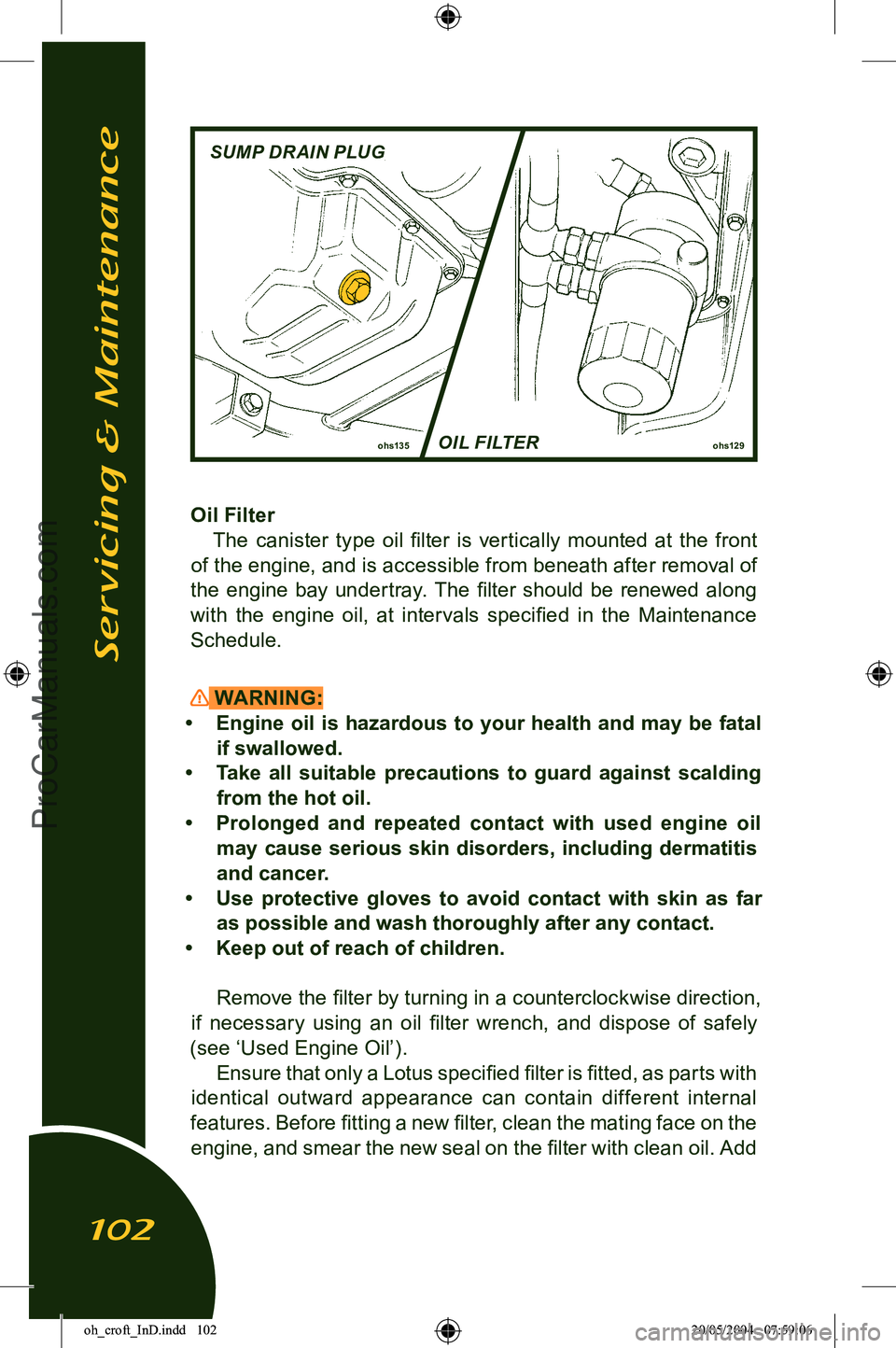
Oil FilterThe canister type oil filter is vertically mounted at the front
of the engine, and is accessible from beneath after removal of
the engine bay undertray. The filter should be renewed along
with the engine oil, at intervals specified in the Maintenance
Schedule.
WARNING:
• Engine oil is hazardous to your health and may be fatal
if swallowed.
• Take all suitable precautions to guard against scalding
from the hot oil.
• Prolonged and repeated contact with used engine oil may cause serious skin disorders, including dermatitis
and cancer.
• Use protective gloves to avoid contact with skin as far
as possible and wash thoroughly after any contact.
• Keep out of reach of children.
Remove the filter by turning in a counterclockwise direction,
if necessary using an oil filter wrench, and dispose of safely
(see ‘Used Engine Oil’). Ensure that only a Lotus specified filter is fitted, as parts with
identical outward appearance can contain different internal
features. Before fitting a new filter, clean the mating face on the engine, and smear the new seal on the filter with clean oil. Add
ohs129
ohs135
SUMP DRAIN PLUG
OIL FILTER
Servicing & Maintenance
102
oh_croft_InD.indd 10220/05/2004 07:59:06ProCarManuals.com
Page 105 of 205
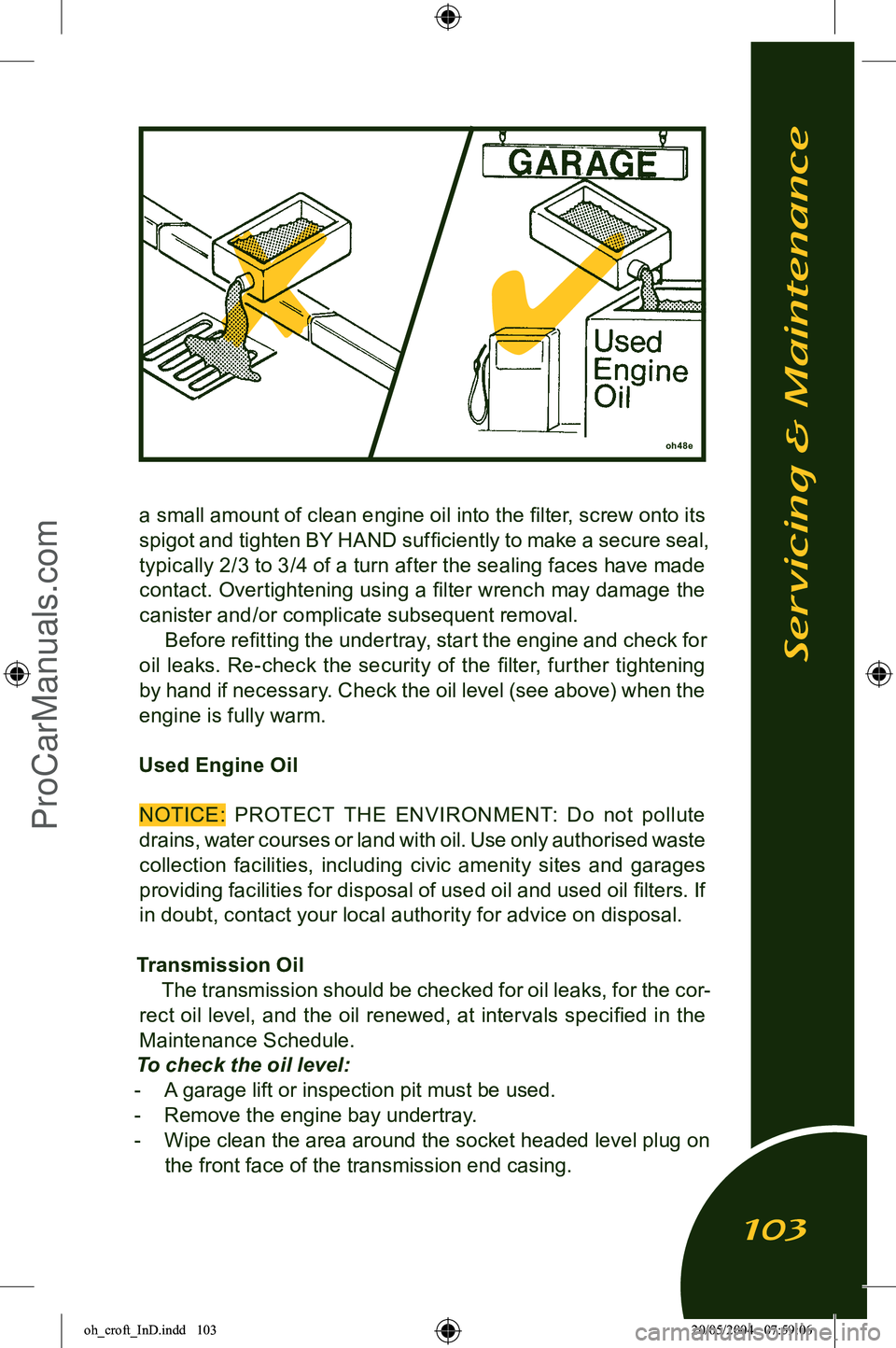
oh48e
a small amount of clean engine oil into the filter, screw onto its
spigot and tighten BY HAND sufficiently to make a secure seal,
typically 2/3 to 3/4 of a turn after the sealing faces have made
contact. Overtightening using a filter wrench may damage the
canister and/or complicate subsequent removal. Before refitting the undertray, start the engine and check for
oil leaks. Re-check the security of the filter, further tightening
by hand if necessary. Check the oil level (see above) when the
engine is fully warm.
Used Engine Oil NOTICE: PROTECT THE ENVIRONMENT: Do not pollute
drains, water courses or land with oil. Use only authorised waste
collection facilities, including civic amenity sites and garages providing facilities for disposal of used oil and used oil filters. If
in doubt, contact your local authority for advice on disposal.
Transmission Oil The transmission should be checked for oil leaks, for the cor
-
rect oil level, and the oil renewed, at intervals specified in the
Maintenance Schedule.
To check the oil level:
- A garage lift or inspection pit must be used.
- Remove the engine bay undertray.
- Wipe clean the area around the socket headed level plug on
the front face of the transmission end casing.
Servicing & Maintenance
103
oh_croft_InD.indd 10320/05/2004 07:59:06ProCarManuals.com
Page 106 of 205
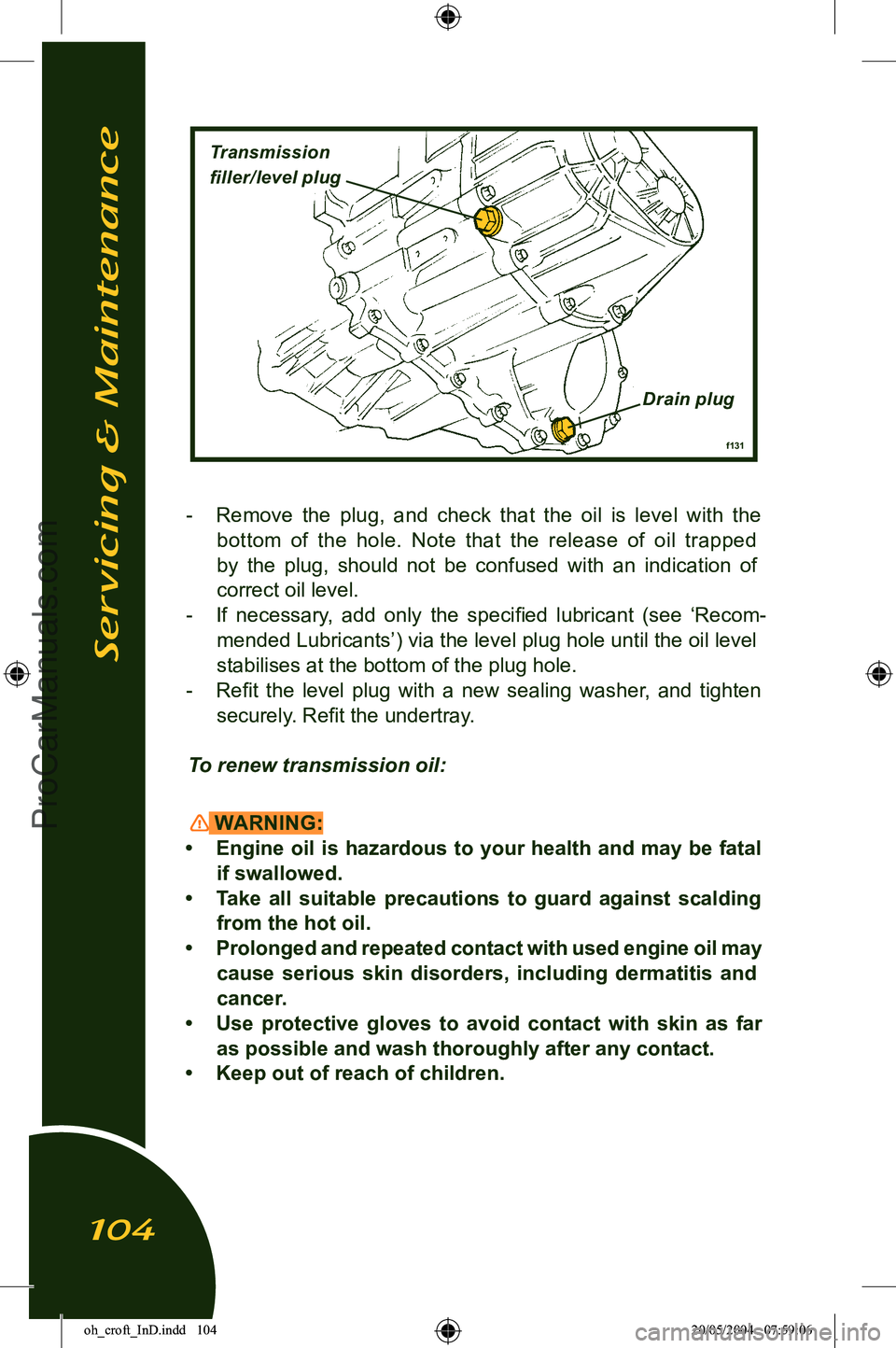
- Remove the plug, and check that the oil is level with the bottom of the hole. Note that the release of oil trapped
by the plug, should not be confused with an indication of
correct oil level.
- If necessary, add only the specified lubricant (see ‘Recom
-
mended Lubricants’) via the level plug hole until the oil level
stabilises at the bottom of the plug hole.
- Refit the level plug with a new sealing washer, and tighten securely. Refit the undertray.
To renew transmission oil:
WARNING:
• Engine oil is hazardous to your health and may be fatal
if swallowed.
• Take all suitable precautions to guard against scalding
from the hot oil.
• Prolonged and repeated contact with used engine oil may cause serious skin disorders, including dermatitis and
cancer.
• Use protective gloves to avoid contact with skin as far as possible and wash thoroughly after any contact.
• Keep out of reach of children.
Servicing & Maintenance
104
f131
Transmission
filler/level plug
Drain plug
oh_croft_InD.indd 10420/05/2004 07:59:06ProCarManuals.com
Page 107 of 205
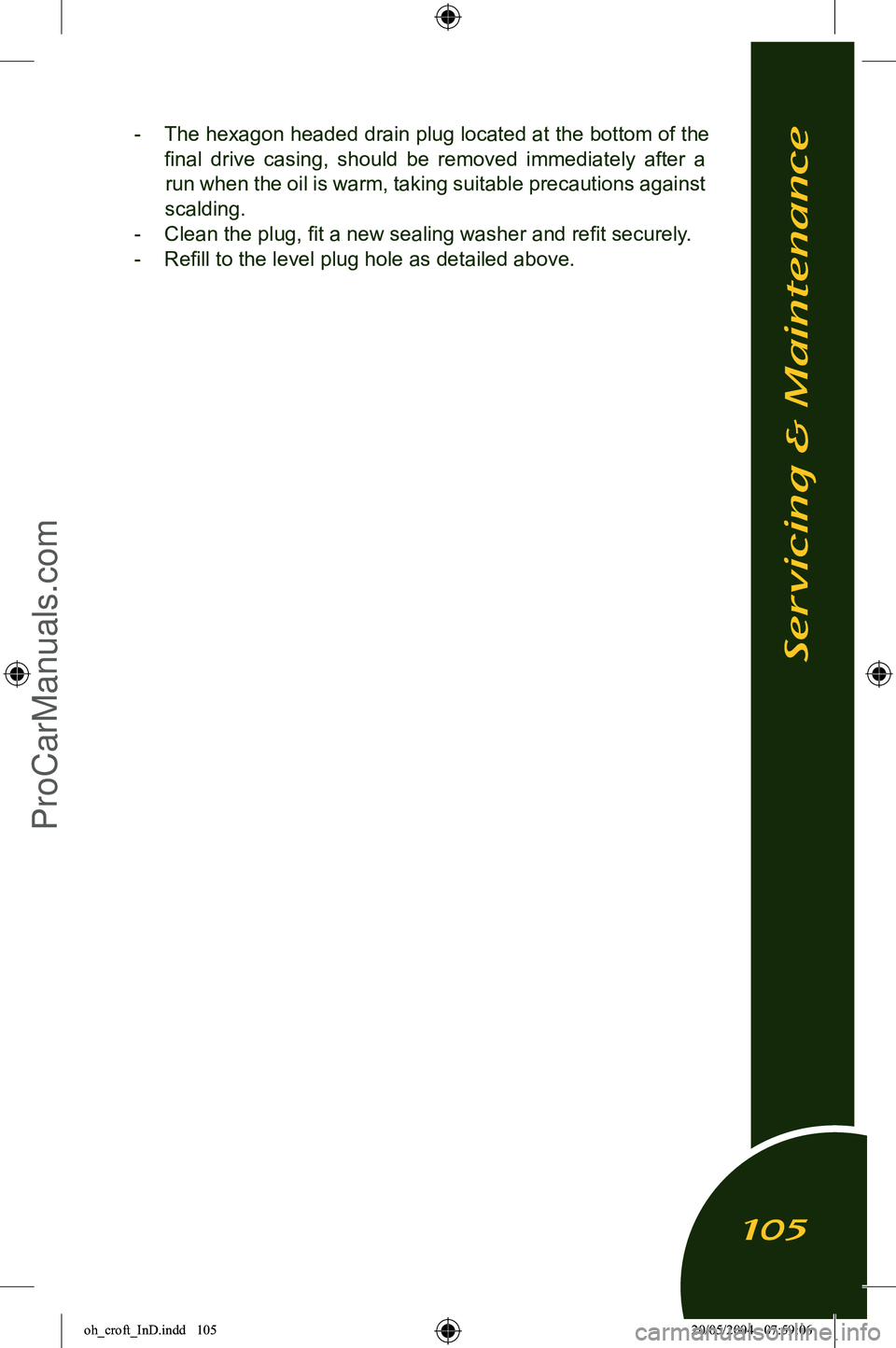
- The hexagon headed drain plug located at the bottom of the final drive casing, should be removed immediately after a run when the oil is warm, taking suitable precautions against
scalding.
- Clean the plug, fit a new sealing washer and refit securely.
- Refill to the level plug hole as detailed above.
Servicing & Maintenance
105
f131
Transmission
filler/level plug
Drain plug
oh_croft_InD.indd 10520/05/2004 07:59:06ProCarManuals.com
Page 108 of 205
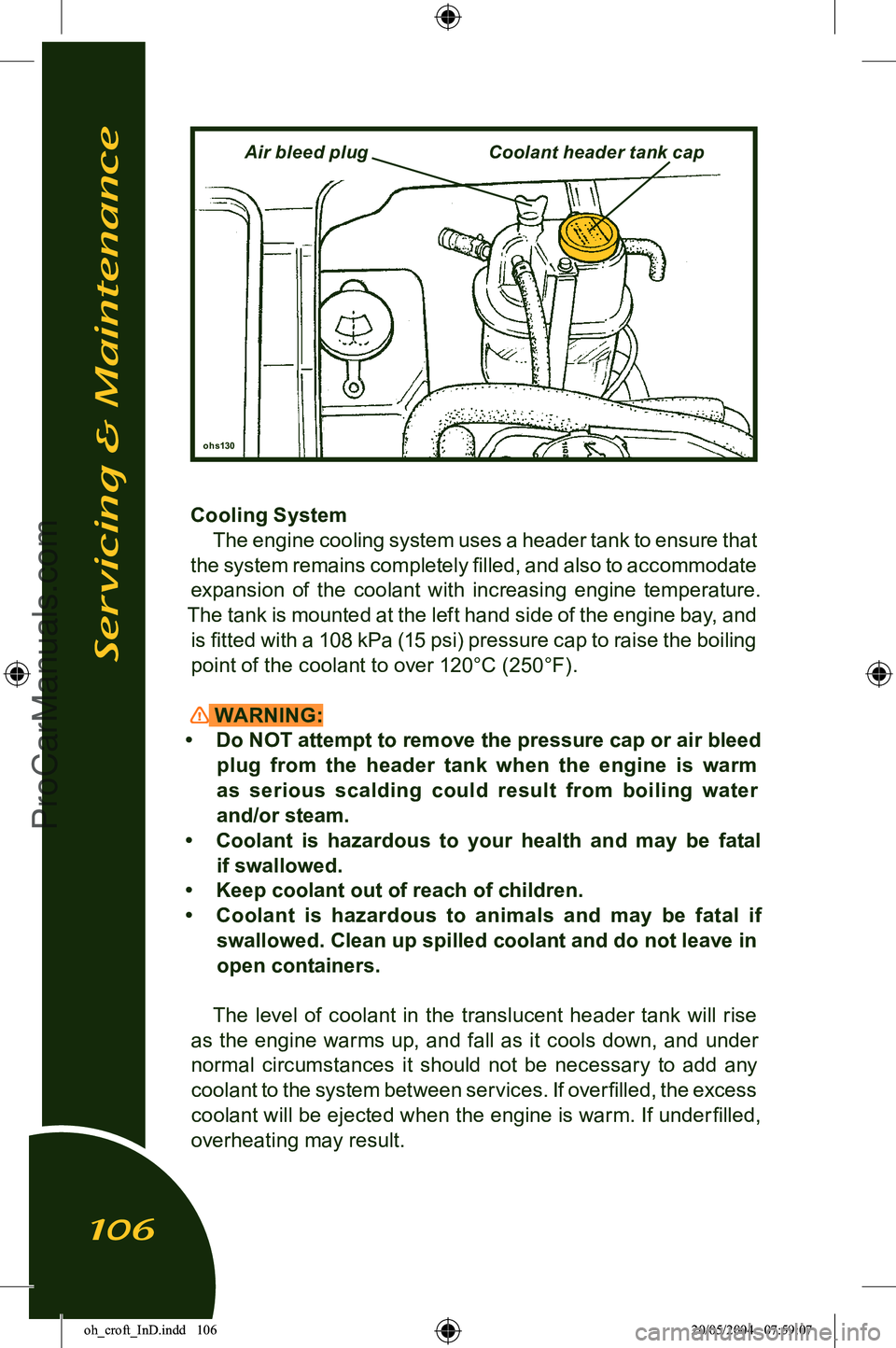
Cooling SystemThe engine cooling system uses a header tank to ensure that
the system remains completely filled, and also to accommodate
expansion of the coolant with increasing engine temperature.
The tank is mounted at the left hand side of the engine bay, and is fitted with a 108 kPa (15 psi) pressure cap to raise the boiling point of the coolant to over 120°C (250°F).
WARNING:
• Do NOT attempt to remove the pressure cap or air bleed plug from the header tank when the engine is warm
as serious scalding could result from boiling water
and/or steam.
• Coolant is hazardous to your health and may be fatal
if swallowed.
• Keep coolant out of reach of children.
• Coolant is hazardous to animals and may be fatal if
swallowed. Clean up spilled coolant and do not leave in
open containers.
The level of coolant in the translucent header tank will rise
as the engine warms up, and fall as it cools down, and under
normal circumstances it should not be necessary to add any
coolant to the system between services. If overfilled, the excess
coolant will be ejected when the engine is warm. If under filled, overheating may result.
Servicing & Maintenance
106
ohs130
Air bleed plugCoolant header tank cap
oh_croft_InD.indd 10620/05/2004 07:59:07ProCarManuals.com
Page 109 of 205
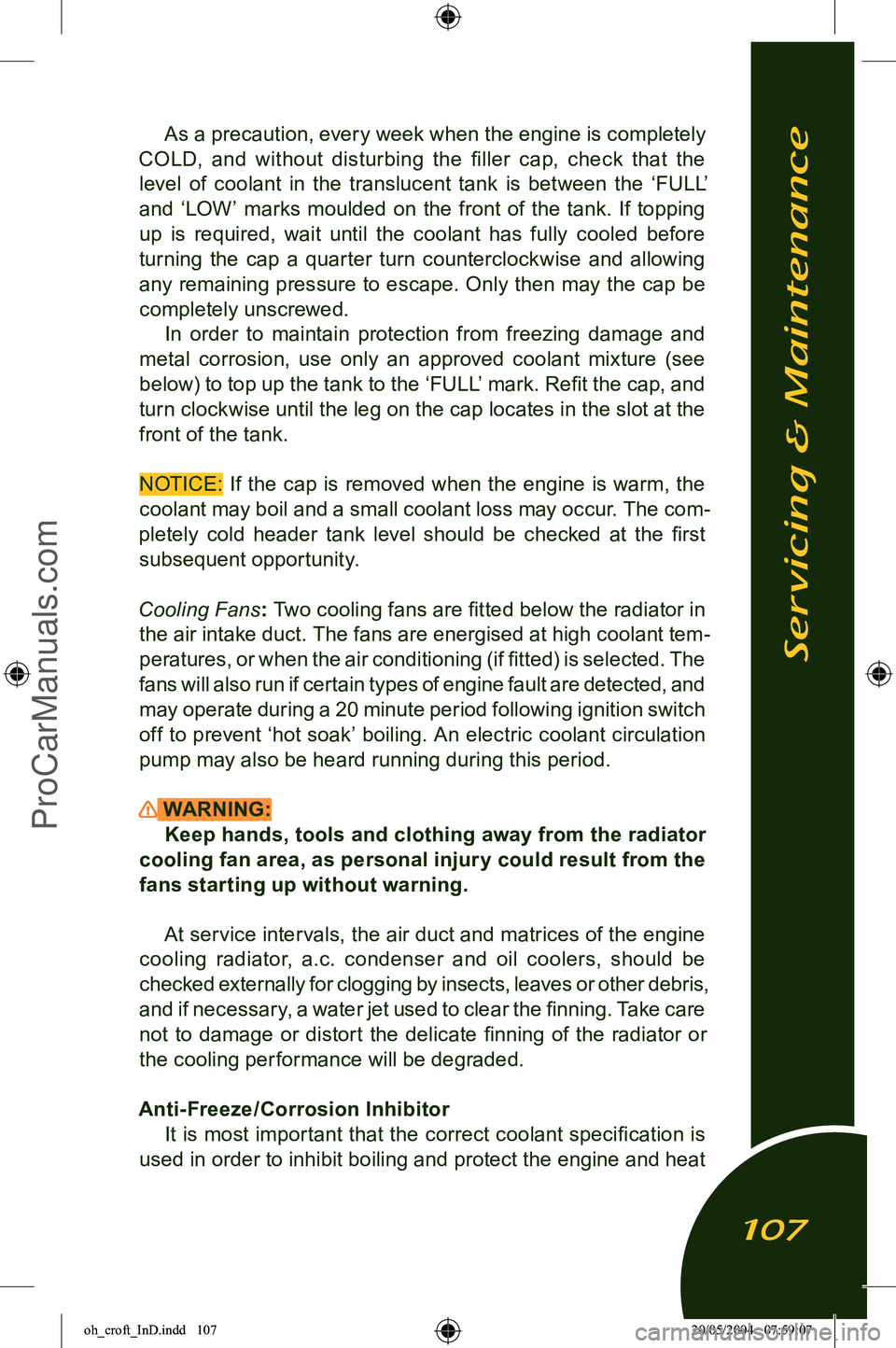
As a precaution, every week when the engine is completely
COLD, and without disturbing the filler cap, check that the level of coolant in the translucent tank is between the ‘FULL’
and ‘LOW’ marks moulded on the front of the tank. If topping
up is required, wait until the coolant has fully cooled before
turning the cap a quarter turn counterclockwise and allowing any remaining pressure to escape. Only then may the cap be
completely unscrewed. In order to maintain protection from freezing damage and
metal corrosion, use only an approved coolant mixture (see below) to top up the tank to the ‘FULL’ mark. Refit the cap, and
turn clockwise until the leg on the cap locates in the slot at the
front of the tank.
NOTICE: If the cap is removed when the engine is warm, the coolant may boil and a small coolant loss may occur. The com
-
pletely cold header tank level should be checked at the first subsequent opportunity.
Cooling Fans
: Two cooling fans are fitted below the radiator in
the air intake duct. The fans are energised at high coolant tem
-
peratures, or when the air conditioning (if fitted) is selected. The
fans will also run if certain types of engine fault are detected, and
may operate during a 20 minute period following ignition switch off to prevent ‘hot soak’ boiling. An electric coolant circulation pump may also be heard running during this period.
WARNING: Keep hands, tools and clothing away from the radiator
cooling fan area, as personal injury could result from the
fans starting up without warning.
At service intervals, the air duct and matrices of the engine
cooling radiator, a.c. condenser and oil coolers, should be
checked externally for clogging by insects, leaves or other debris,
and if necessary, a water jet used to clear the finning. Take care not to damage or distort the delicate finning of the radiator or
the cooling performance will be degraded.
Anti-Freeze/Corrosion Inhibitor It is most important that the correct coolant specification is
used in order to inhibit boiling and protect the engine and heat
Servicing & Maintenance
107
oh_croft_InD.indd 10720/05/2004 07:59:07ProCarManuals.com
Page 115 of 205
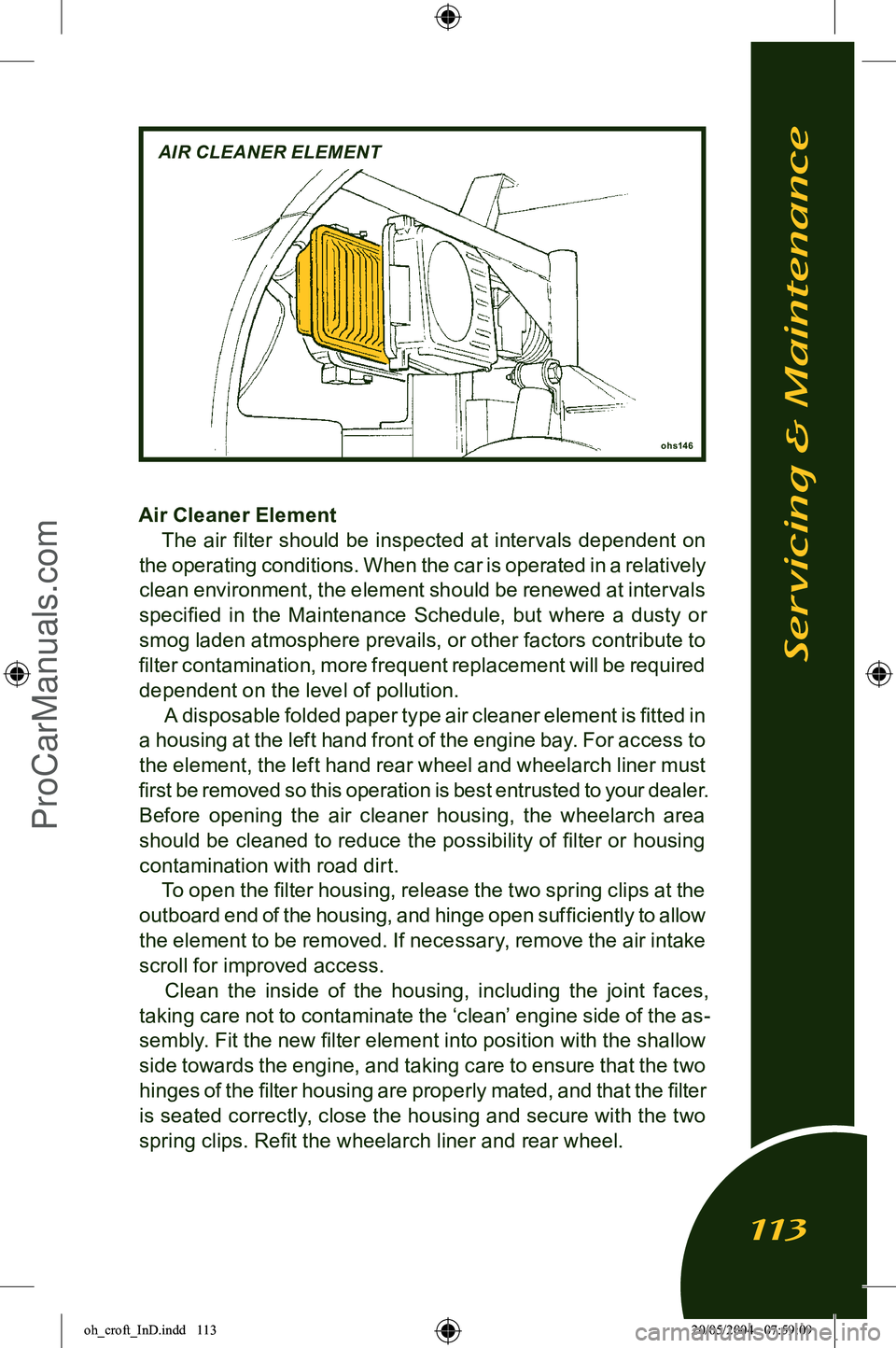
Air Cleaner ElementThe air filter should be inspected at intervals dependent on
the operating conditions. When the car is operated in a relatively
clean environment, the element should be renewed at intervals
specified in the Maintenance Schedule, but where a dusty or
smog laden atmosphere prevails, or other factors contribute to
filter contamination, more frequent replacement will be required
dependent on the level of pollution. A disposable folded paper type air cleaner element is fitted in
a housing at the left hand front of the engine bay. For access to
the element, the left hand rear wheel and wheelarch liner must
first be removed so this operation is best entrusted to your dealer.
Before opening the air cleaner housing, the wheelarch area
should be cleaned to reduce the possibility of filter or housing contamination with road dirt. To open the filter housing, release the two spring clips at the
outboard end of the housing, and hinge open sufficiently to allow
the element to be removed. If necessary, remove the air intake scroll for improved access. Clean the inside of the housing, including the joint faces,
taking care not to contaminate the ‘clean’ engine side of the as
-
sembly. Fit the new filter element into position with the shallow
side towards the engine, and taking care to ensure that the two
hinges of the filter housing are properly mated, and that the filter
is seated correctly, close the housing and secure with the two
spring clips. Refit the wheelarch liner and rear wheel.
ohs146
AIR CLEANER ELEMENT
Servicing & Maintenance
113
oh_croft_InD.indd 11320/05/2004 07:59:09ProCarManuals.com
Page 122 of 205
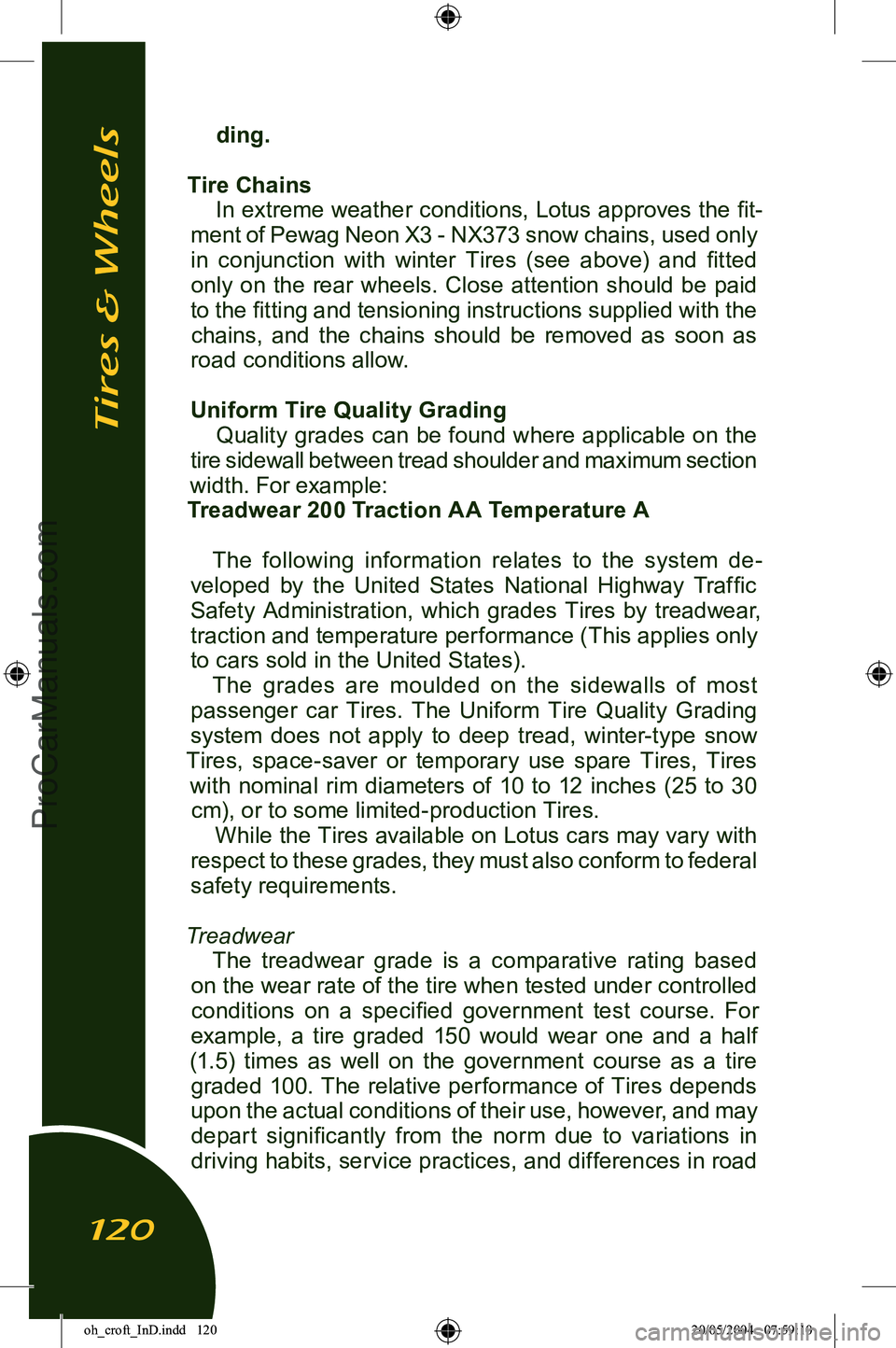
ding.
Tire Chains In extreme weather conditions, Lotus approves the fit
-
ment of Pewag Neon X3 - NX373 snow chains, used only in conjunction with winter Tires (see above) and fitted only on the rear wheels. Close attention should be paid
to the fitting and tensioning instructions supplied with the chains, and the chains should be removed as soon as
road conditions allow.
Uniform Tire Quality Grading Quality grades can be found where applicable on the
tire sidewall between tread shoulder and maximum section
width. For example:
Treadwear 200 Traction AA Temperature A
The following information relates to the system de
-
veloped by the United States National Highway Traffic
Safety Administration, which grades Tires by treadwear, traction and temperature performance (This applies only
to cars sold in the United States). The grades are moulded on the sidewalls of most
passenger car Tires. The Uniform Tire Quality Grading system does not apply to deep tread, winter-type snow
Tires, space-saver or temporary use spare Tires, Tires with nominal rim diameters of 10 to 12 inches (25 to 30 cm), or to some limited-production Tires. While the Tires available on Lotus cars may vary with
respect to these grades, they must also conform to federal safety requirements.
Treadwear The treadwear grade is a comparative rating based
on the wear rate of the tire when tested under controlled
conditions on a specified government test course. For example, a tire graded 150 would wear one and a half
(1.5) times as well on the government course as a tire graded 100. The relative performance of Tires depends
upon the actual conditions of their use, however, and may depart significantly from the norm due to variations in
driving habits, service practices, and differences in road
Tires & Wheels
120
oh_croft_InD.indd 12020/05/2004 07:59:10ProCarManuals.com
Page 127 of 205
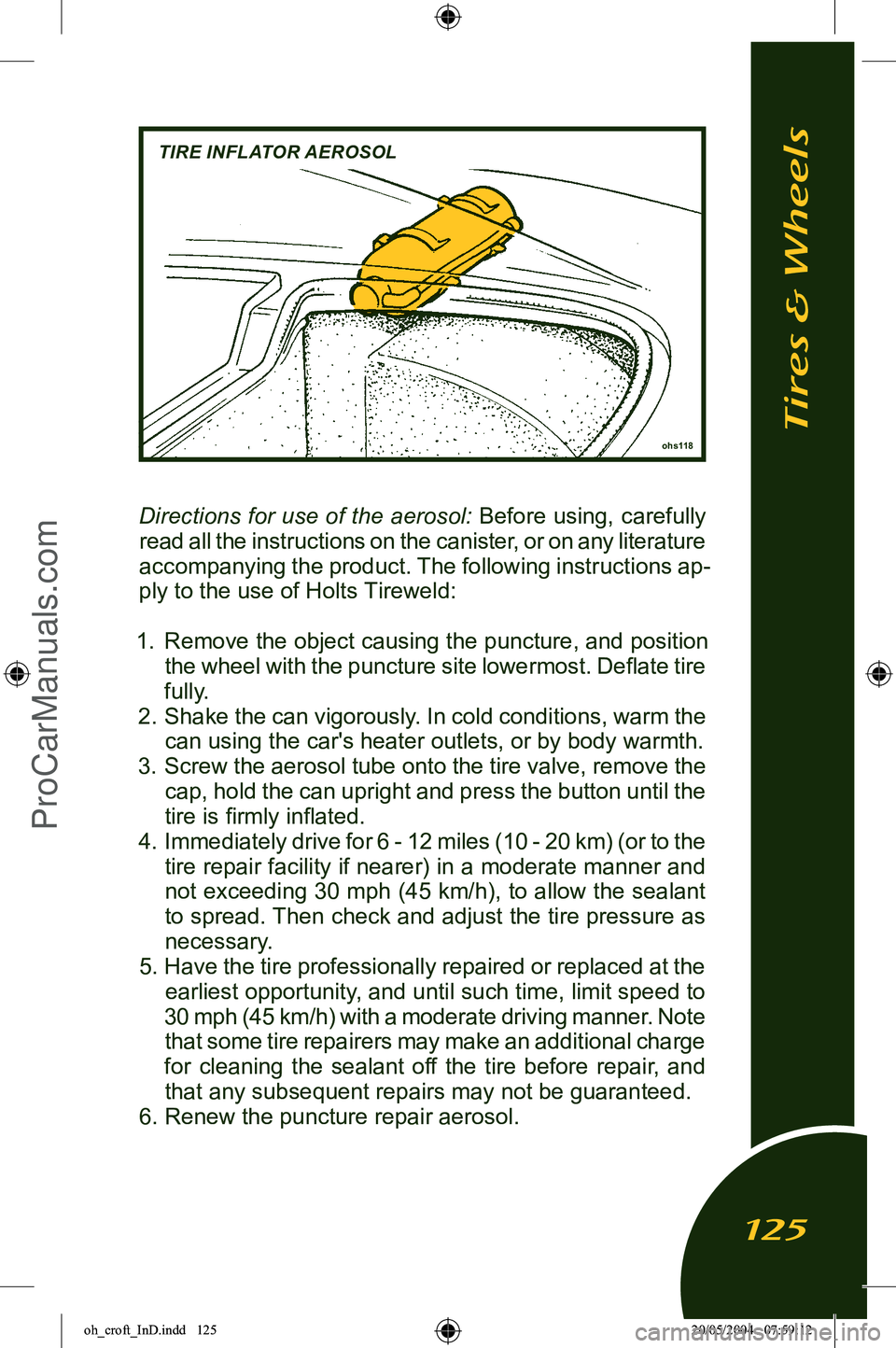
Directions for use of the aerosol: Before using, carefully read all the instructions on the canister, or on any literature
accompanying the product. The following instructions ap
-
ply to the use of Holts Tireweld:
1. Remove the object causing the puncture, and position the wheel with the puncture site lowermost. Deflate tire
fully.
2. Shake the can vigorously. In cold conditions, warm the
can using the car's heater outlets, or by body warmth.
3. Screw the aerosol tube onto the tire valve, remove the cap, hold the can upright and press the button until the
tire is firmly inflated.
4. Immediately drive for 6 - 12 miles (10 - 20 km) (or to the tire repair facility if nearer) in a moderate manner and not exceeding 30 mph (45 km/h), to allow the sealant
to spread. Then check and adjust the tire pressure as necessary.
5. Have the tire professionally repaired or replaced at the earliest opportunity, and until such time, limit speed to
30 mph (45 km/h) with a moderate driving manner. Note that some tire repairers may make an additional charge
for cleaning the sealant off the tire before repair, and
that any subsequent repairs may not be guaranteed.
6. Renew the puncture repair aerosol.
ohs118
TIRE INFLATOR AEROSOL
Tires & Wheels
125
oh_croft_InD.indd 12520/05/2004 07:59:12ProCarManuals.com